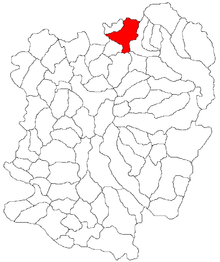Constantin Daicoviciu (Caraș-Severin)
|
Constantin Daicoviciu, Căvăran Kawaran Kavarán |
||||
|
||||
| Basic data | ||||
|---|---|---|---|---|
| State : |
|
|||
| Historical region : | Banat | |||
| Circle : | Caraș-Severin | |||
| Coordinates : | 45 ° 33 ' N , 22 ° 9' E | |||
| Time zone : | EET ( UTC +2) | |||
| Area : | 105.29 km² | |||
| Residents : | 2,920 (2014) | |||
| Population density : | 28 inhabitants per km² | |||
| Postal code : | 327090 | |||
| Telephone code : | (+40) 02 55 | |||
| License plate : | CS | |||
| Structure and administration (as of 2016) | ||||
| Community type : | local community | |||
| Structure : | Constantin Daicoviciu, Maciova , Mâtnicu Mare , Peştere , Prisaca , Zăgujeni | |||
| Mayor : | Boambeș Daniel ( PSD ) | |||
| Postal address : | Str. Principală, no. 11 loc. Constantin Daicoviciu, jud. Caraș-Severin, RO-327090 |
|||
| Website : | ||||
Constantin Daicoviciu (until 1974 Căvăran , German: Kawaran , Hungarian: Kavarán ) is a municipality in the Caraș-Severin County , Banat , Romania . The villages of Maciova , Mâtnicu Mare , Peştere , Prisaca and Zăgujeni also belong to the municipality of Constantin Daicoviciu .
Geographical location
Constantin Daicoviciu is located in the north of the Caraș-Severin County, at the foot of the Poiana-Ruscă Mountains . The village is located in the Timişoara Valley , on the European route E94 Bucureşti - Timişoara , 15 km from Caransebeş .
Neighboring places
| Sacu | Tincova | Poiana Ruscă Mountains |
| Zgribeşti |

|
Poiana Ruscă Mountains |
| Copăcele | Prisaca | Maciova |
history
The village was first mentioned in a document in 1371, when Queen Elisabeth and King Ludwig I passed a judgment in favor of the Cavaran's serfs . On October 14, 1447, Johann Hunyadi stayed in Cavaran. Gabriel Báthory mentioned the village of Karan in a letter in 1626 .
On the Josephine land survey of 1717 the place Caveran is registered with 30 houses. After the Peace of Passarowitz (1718) the village was part of the Habsburg crown domain Temescher Banat . At this time Cavaran is registered as a city, "opidium" or "civitas".
As a result of the Austro-Hungarian Compromise (1867), the Banat was annexed to the Kingdom of Hungary within the dual monarchy of Austria-Hungary . The official place name was Kavarán .
The Treaty of Trianon on June 4, 1920 resulted in the triple division of the Banat , whereby Căvăran fell to the Kingdom of Romania . In 1974 the name of the village was named after the son of the community, university professor of historian and archaeologist Constantin Daicoviciu .
Population development
| census | Ethnicity | |||||||
|---|---|---|---|---|---|---|---|---|
| year | Residents | Romanians | Hungary | German | Other | |||
| 1880 | 617 | 589 | 5 | 21st | 2 | |||
| 1910 | 862 | 772 | 38 | 49 | 3 | |||
| 1930 | 859 | 765 | 43 | 35 | 16 | |||
| 1977 | 775 | 735 | 6th | 16 | 18th | |||
| 2002 | 763 | 712 | 4th | 3 | 44 | |||
Personalities
- Constantin Daicoviciu (March 1, 1898– May 27, 1973), historian, archaeologist and rector of the Babes Bolyai University in Cluj
Web links
- ghidulprimariilor.ro , Constantin Daicoviciu
- primariaconstantindaicoviciu.ro , Constantin Daicoviciu Citizens' Registration Office
- banaterra.eu , Constantin Daicoviciu
Individual evidence
- ↑ Mayoral elections 2016 in Romania ( MS Excel ; 256 kB)
- ↑ a b c d primariaconstantindaicoviciu.ro , Constantin Daicoviciu
- ↑ kia.hu (PDF; 858 kB), E. Varga: Statistics of the number of inhabitants by ethnicity in the Caraș-Severin district according to censuses from 1880 - 2002



